TechRadar Verdict
By lowering the price and focusing solely on entertainment, OnePlus has created a great value tablet that’ll make for a solid companion on any long trip.
Pros
- +
A great, cinematic screen
- +
Excellent value
- +
Clean take on Android
- +
Long period of software updates
Cons
- -
Not great for productivity
- -
Too big to be used for reading
- -
There are better tablets for more intensive games
Why you can trust TechRadar
OnePlus Pad Lite: two-minute review
If you want a great-looking tablet for entertainment that comes with an affordable price tag yet isn’t bogged down by the usual bloatware you tend to see at this end of the market, then the OnePlus Pad Lite is exactly what you need.
The 11-inch touchscreen offers up a far more immersive viewing experience than your smartphone, but its relatively slim build allows it to be carried around in a bag without it ever feeling cumbersome. If you have limited bag space when traveling on a flight, the Pad Lite is exactly the type of all-in-one entertainment device that you’ll want to have on your person.
What ties the whole thing together is OnePlus’ brilliant OxygenOS overlay. Being just a step below stock Android (the likes of which you’ll pretty much find on the best Pixel phones), OnePlus’ take on Android has an appealing aesthetic across the board. But more importantly, any presence of bloatware is kept to the bare minimum, which is a rare thing when it comes to cheaper tablets.
As you might expect, there are some limitations to contend with. More intense 3D games do push the MediaTek Helio G100 chipset to its limits. So if you do fancy playing the likes of Ghenshin Impact or Honkai: Star Rail but on a larger display, then you may want to check out one of the best tablets instead.
The weight of the OnePlus Pad Lite when held vertically also makes it less than ideal when it comes to reading. If you do plan on getting through an e-book or two while on your holidays then I think you’ll be better off with an iPad mini, one of Amazon’s smaller Fire Tablets or even one of the best e-readers like the Amazon Kindle.
This also isn’t a great tablet for productivity. You can get away with light multitasking via the excellent Open Canvas software, but more power-hungry combinations can bring about a fair bit of slowdown. Still, I didn’t expect this tablet to be a productivity powerhouse, particularly as that’s exactly why the OnePlus Pad 3 exists.
To my mind, the OnePlus Pad Lite is another example of what the best budget tablets do so well, especially in the Android space. As a means of enjoying your favourite films and TV shows on the go, it’s hard to argue with the value that OnePlus has put together here.
Sign up for breaking news, reviews, opinion, top tech deals, and more.
OnePlus Pad Lite review: price and availability
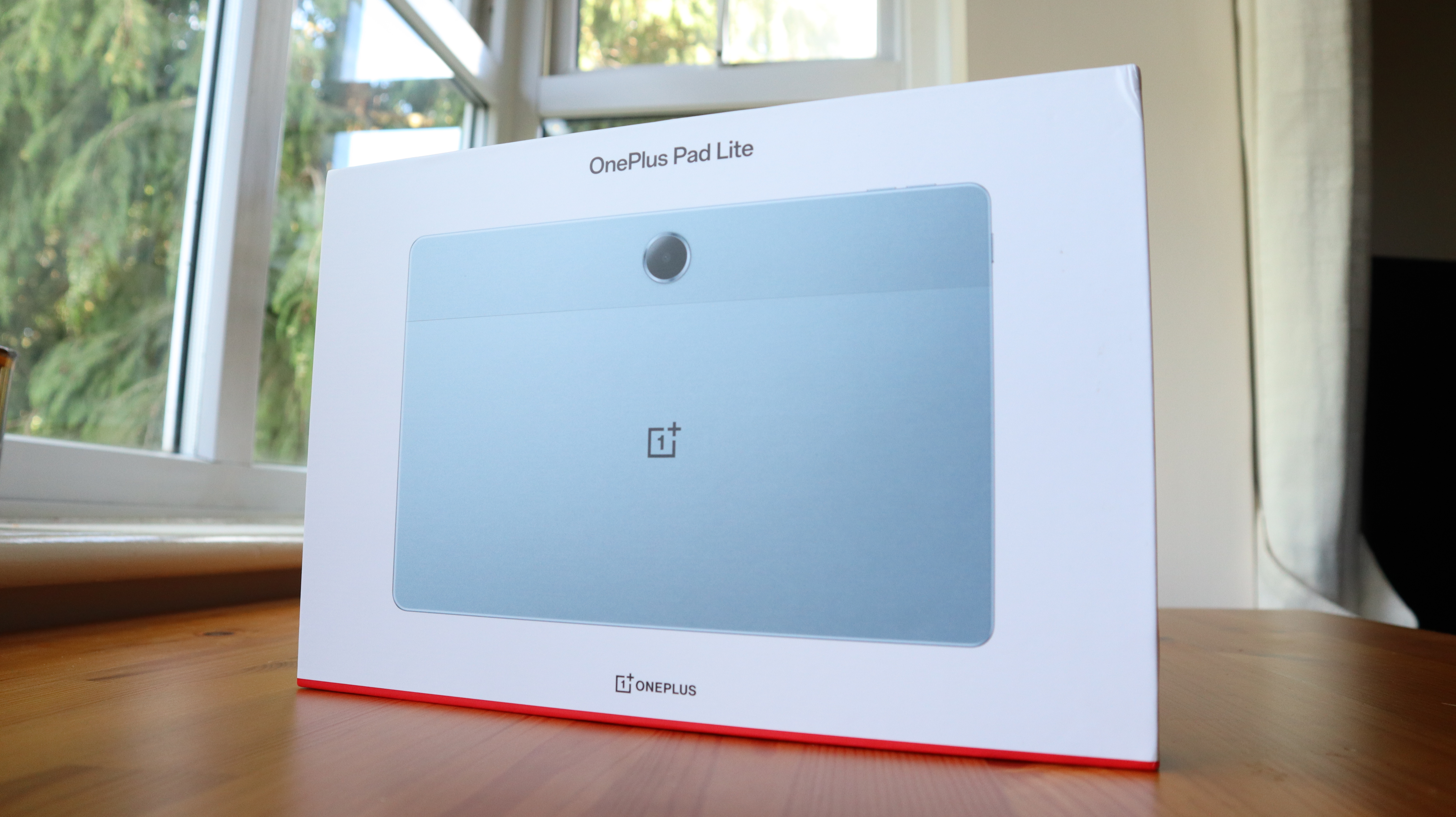
- Starts at £199 / €229 for 6GB of RAM and 128GB storage
- A more expensive 8GB RAM/128GB storage model is available, although US availability for either option has yet to be announced
The OnePlus Pad Lite has been framed as a far more budget-friendly alternative to the super powered OnePlus Pad 3, with a starting price of £199 in the UK. At the time of writing, US pricing has not been announced, Although OnePlus has unveiled pricing for Europe, Denmark and Sweden at €229, 1799DKK and 2790SEK respectively.
The entry-level model comes with 6GB RAM and 128GB storage, while an upgraded version bumps the available RAM to 8GB and includes LTE functionality for an on-the-go internet connection. This latter option bumps the price to £229 / €259 / 1999DKK / 2990SEK.
Much like the OnePlus Pad Go (the company’s previous budget tablet), the OnePlus Pad Lite is only available in a single colour: Aero Blue. Unlike the Pad Go, however, the Pad Lite appears to be far more aggressive in its pricing with regards to attracting the more affordable end of the market.
The OnePlus Pad Go launched with a starting price of £299, making it a whole £100 more expensive than the Pad Lite. Not only does this make the Pad Lite more competitive against similar budget tablets from the likes of Amazon, but it also massively undercuts the entry-level iPad 11, which has a starting price of £329/$349.
There’s a single official accessory launching alongside the device, the OnePlus Pad Lite Folio Case, priced at £34.99/€34.99. The tablet itself will be available for purchase from August 14th.
- Value score: 4 / 5
OnePlus Pad Lite review: specs
Starting price | £199 |
Operating system | OxygenOS 15.0.1 |
Chipset | MediaTek Helio G100 |
Memory (RAM) | 6GB/8GB |
Storage | 128GB |
Display | 11-inch 1920 x 1200 LCD, 90Hz |
Weight | 530g |
Battery | 9,340mAh |
Charging | 33W wired charging |
Cameras | 5MP main, 5MP front |
It does seem a bit odd that the upgraded LTE model of the OnePlus Pad Lite doesn’t include a bump to the storage. 128GB is more than enough to keep kids busy with child-friendly apps and shows. But if you’re an adult who wants a reliable tablet for entertainment, storing plenty of offline files for use when travelling, then a 256GB option would have been appreciated.
What is great to see is in spite of lowering the price against the OnePlus Pad Go, the Lite actually has a larger battery than its spiritual predecessor, so there’s more bang for your buck in that regard.
OnePlus Pad Lite review: display
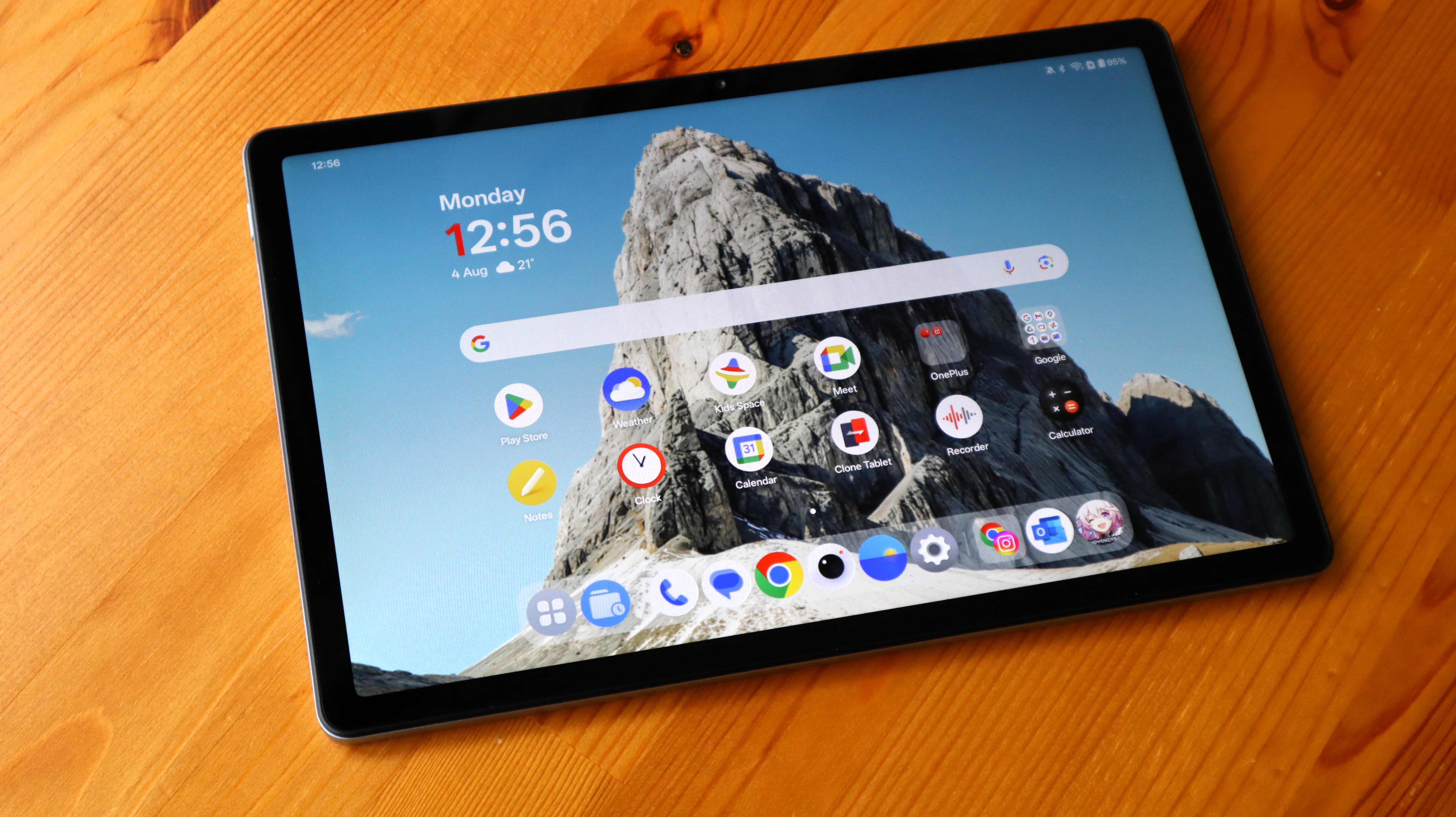
- Cinematic 11-inch LCD panel
- Auto-brightness could be better
OnePlus Pad Lite spots an 11-inch 90Hz IPS LCD display, and while it did take a moment for my eyes to adjust their expectations after the super bright 13.20-inch 3.4K display of the OnePlus Pad 3, I did come to appreciate what the company is offering here.
To get that 11-inch sizing for quite an affordable price against the competition does make the Pad Lite feel like an obvious choice for anyone who travels a fair bit and would rather have a display that’s larger than their phone, and better suited for entertainment.
The 1920 x 1200 resolution does look quite good from a distance, although if you have had the privilege of using a nicer tablet before then you will pick up on a certain loss of sharpness when kicking back with a movie or a show. Thankfully, it’s not something that your eyes will focus on as the wide-screen, in partnership with some cinematic letterboxing, does pave the way for an immersive experience.
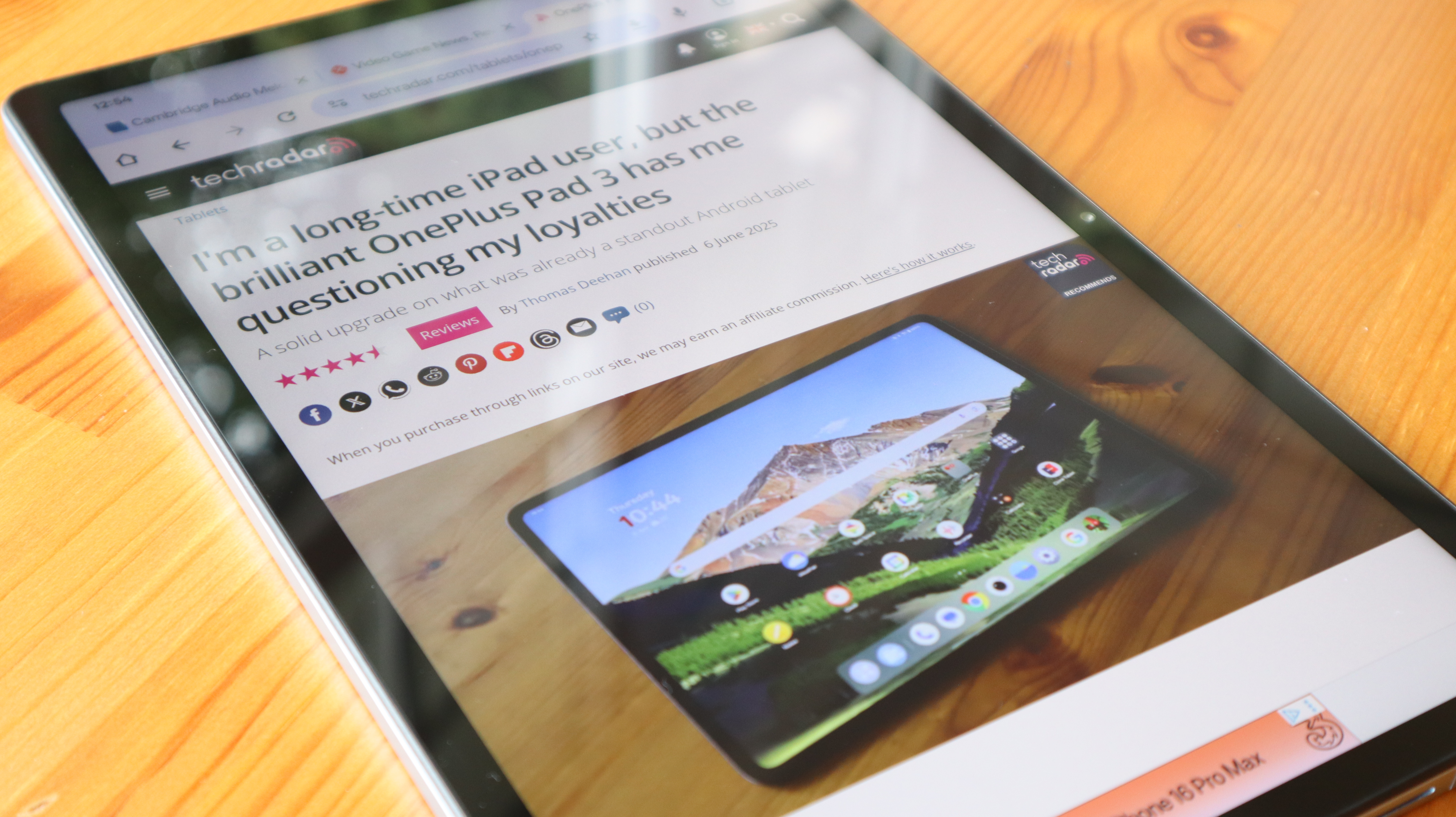
My go-to test with these tablets is pretty much any scene from the final third of Avengers: Infinity War, and let me tell you that I was just as engrossed here as with any other time I’ve watched it. Especially with the battle of Wakanda, the wide-ratio of the IMAX enhanced stream made the action feel more expansive, with plenty going on in the background. Compared to watching movies on your phone, this is a real treat.
The display itself is very responsive, and the somewhat sizeable bezels helped to prevent any instances of accidental touch-recognition, which I’m grateful for on a device like this. The only aspect I had much of an issue with was the brightness.
With a peak of 500 nits, you won’t be squinting when the display is firing on all cylinders. However, the auto-brightness was always a touch dimmer than I needed it to be, so I ended up taking the brightness into my own hands, which is hardly ideal as you move from one location to another.
- Display score: 4 / 5
OnePlus Pad Lite review: design
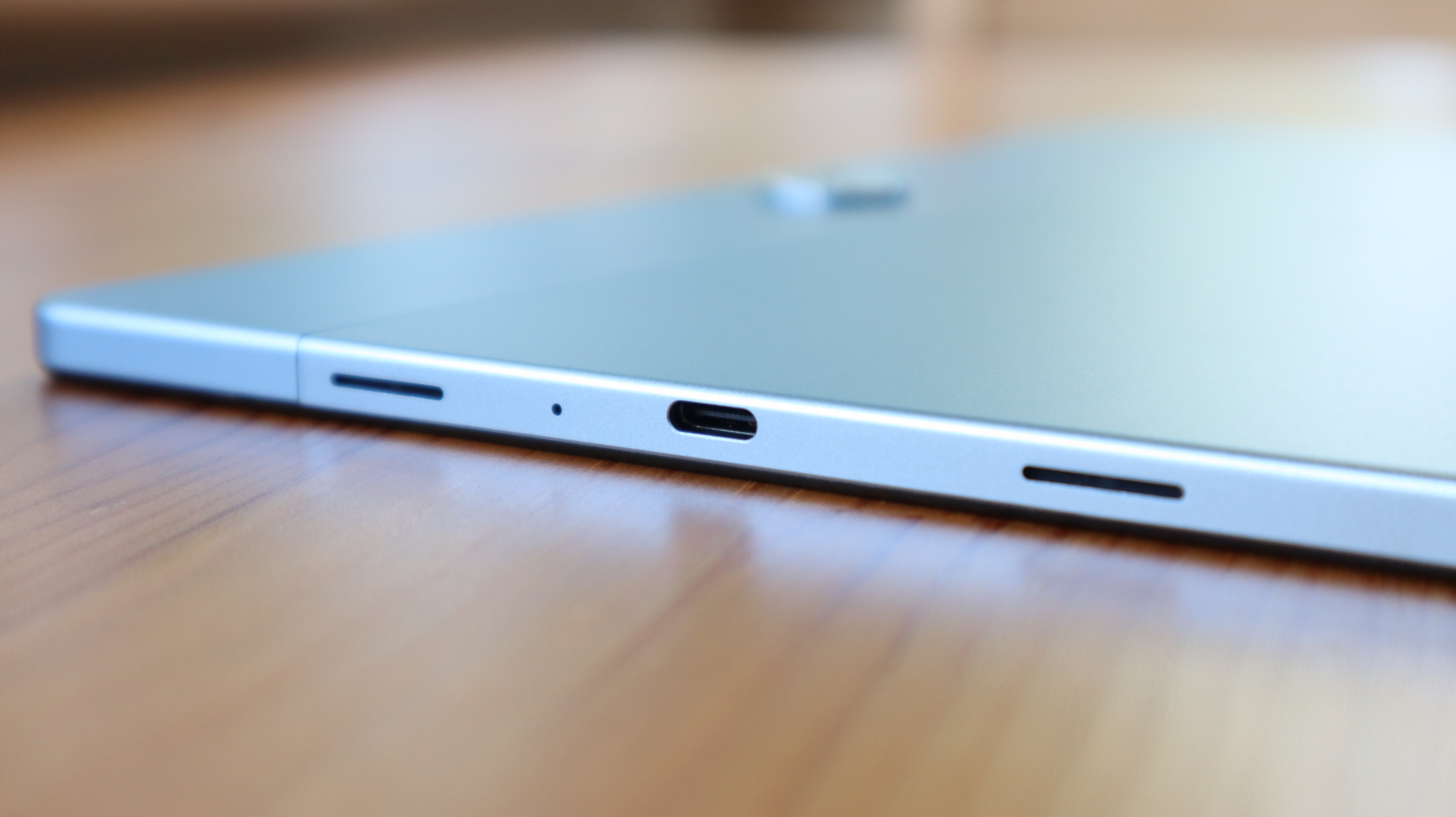
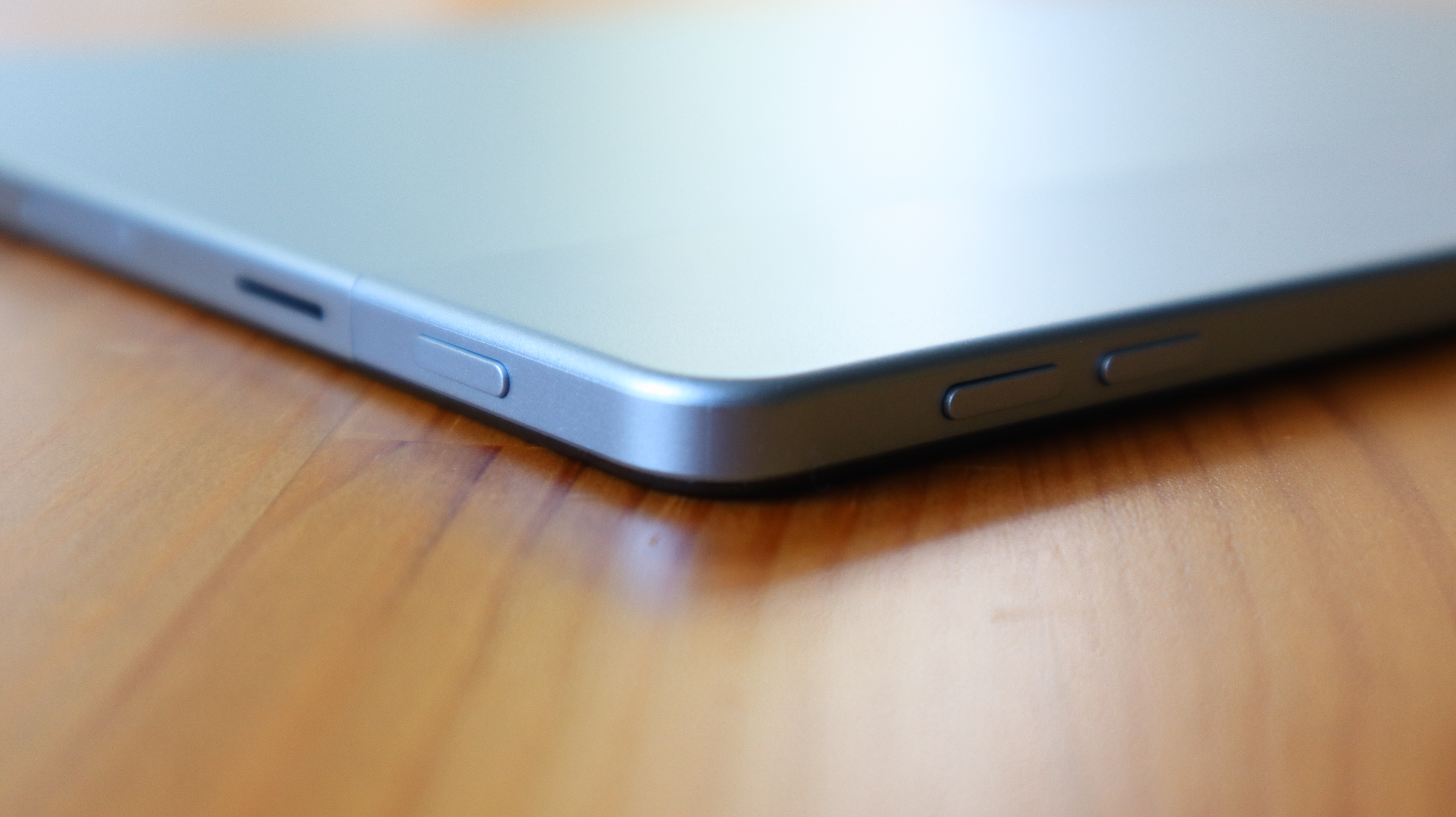
- Very portable frame
- Just one colour option
If there’s one area where the OnePlus Pad Lite has done one heck of a job in replicating the brand's Pad 3, it’s in the design. At just 7.39mm thick, it’s not quite as slim as the Pad 3’s 5.97mm build, but it's very close and you’ll barely notice its presence when put away in a rucksack.
While there is just one colour available, OnePlus’ Aero Blue aesthetic is very nice to look at, and with the tablet weighing 530g, it has a nice feeling of heft in the hand that contributes to the sense that this isn’t really a budget tablet at all.
When held horizontally, the Pad Lite feels comfortable and I can’t imagine there being any issues on this front if you have a long-haul flight planned and seek to use the tablet as your main entertainment device. Unfortunately, I can’t quite say the same about using the Pad Lite vertically.
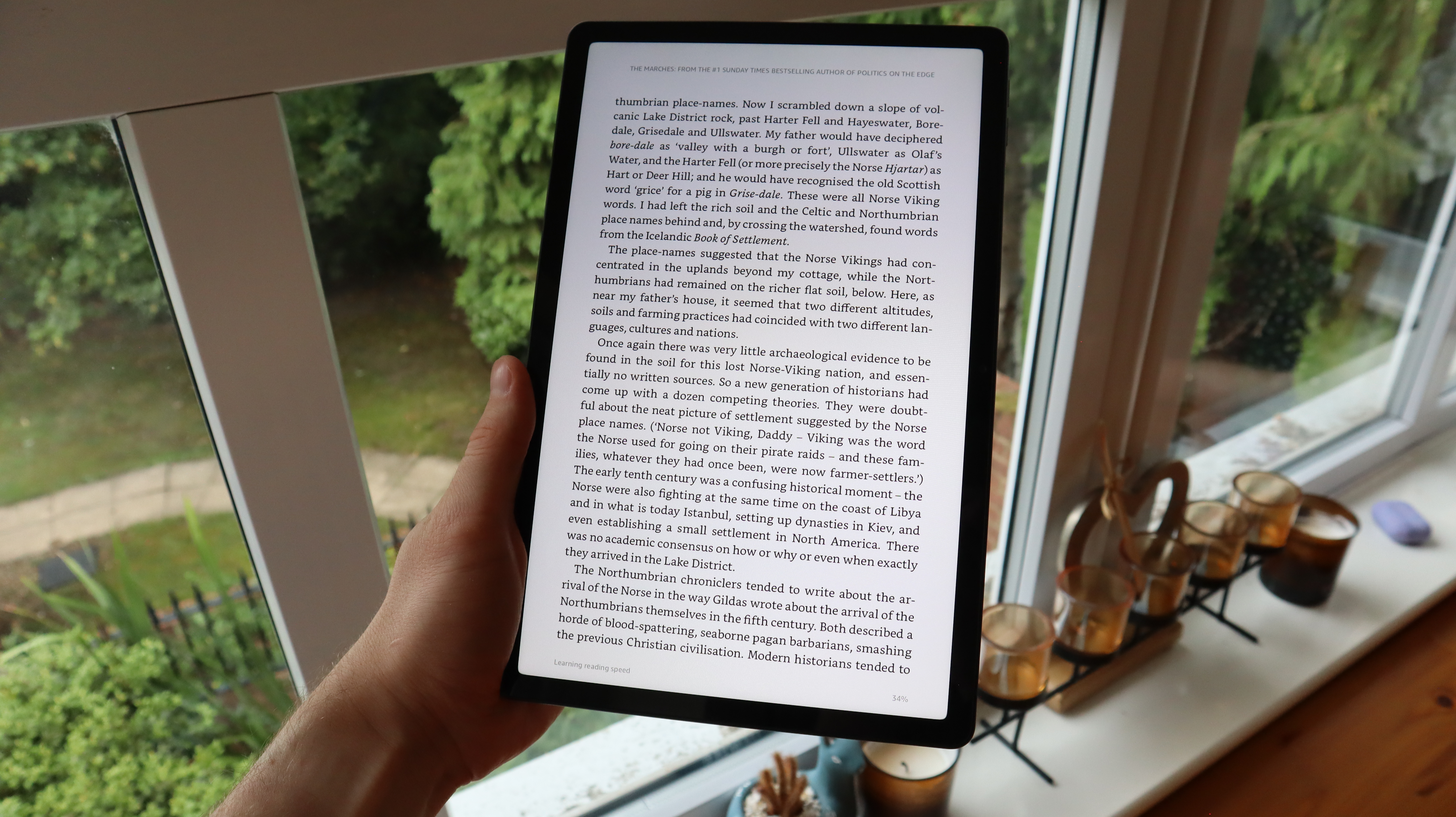
With a height of 254.9mm and a width of 166.5mm, the Pad Lite is just a bit too big for vertical use, and after a while I could feel the weight of the tablet lifting it out of my hands. This isn’t great for any vertical games like Beatstar, or even reading apps, which are just better suited in an upright position.
This issue could be rectified by resting your hands on either side of the tablet’s centre, but then you’d have a protruding section at the bottom which isn’t ideal if you want to lie back and read an ebook. If you do plan on picking up a tablet for reading then I think you’ll be better off with something smaller like the iPad Mini or the Amazon Fire 7 Tablet.
- Design score: 4 / 5
OnePlus Pad Lite review: software
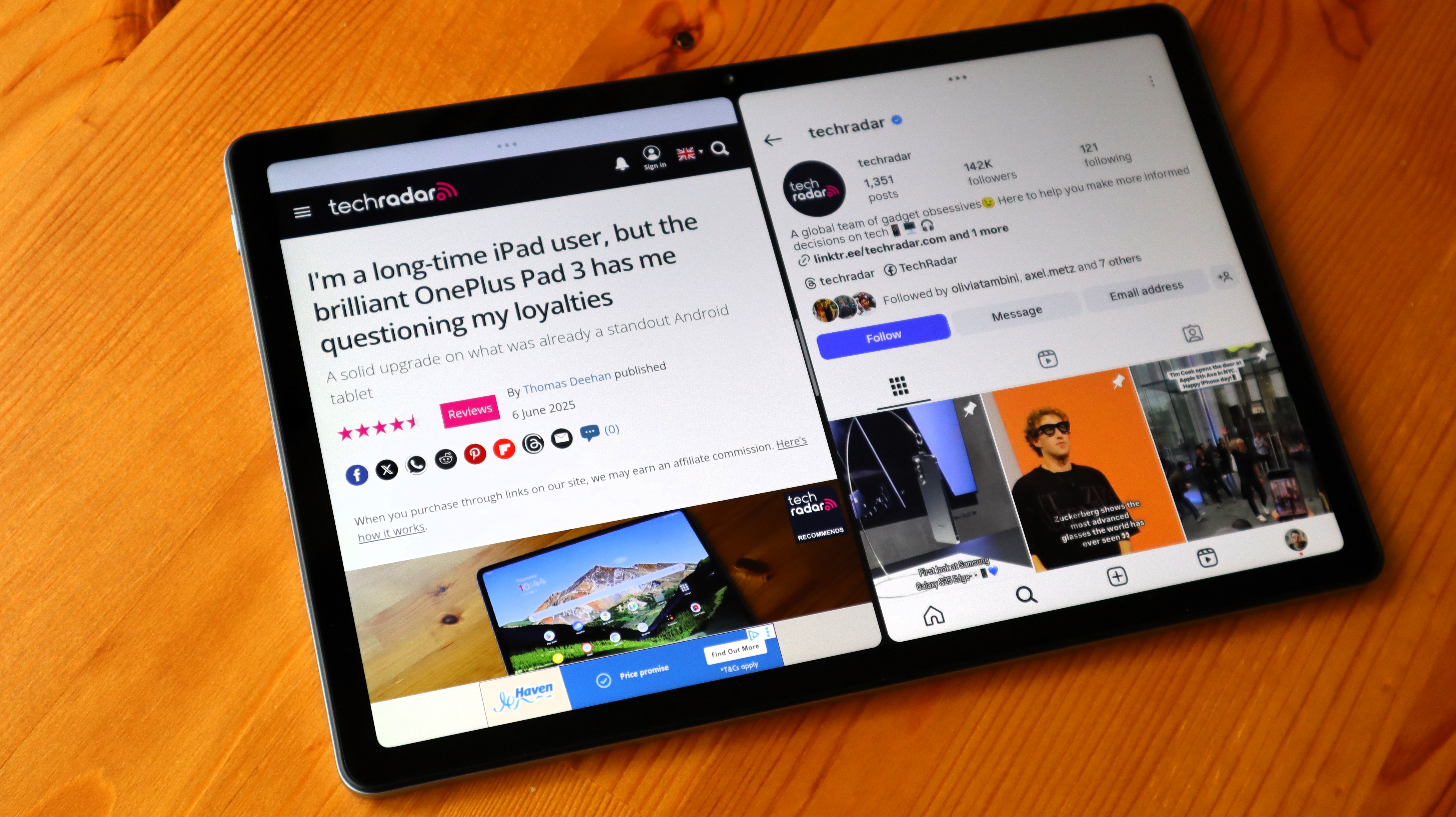
- OxygenOS remains one of the best versions of Android
- Open Canvas is solid for light tasks, but not for moments of productivity
A key reason why I loved the OnePlus Pad 3 so much is that OxygenOS is by far one of the most feature packed Android overlays on the market, and thankfully that sentiment continues with the Pad Lite.
For starters, even though the Pad Lite does carry a budget price tag, there's next to no bloatware which already sets it apart from the competition. I recently tested the mid-range Redmagic 10S Pro and was dismayed by how much bloatware came with that phone, so to see OnePlus going against the grain by providing a more premium-feeling software experience for under £200, is worth commending.
OxygenOS itself also has a clean aesthetic which makes scrolling through menus and tweaking the UI feel like an inviting prospect. It’s not quite as eye-catching as stock Android on the Google Pixel Tablet, but it works well.
OnePlus’ multitasking software, Open Canvas, also makes a reappearance here but I’ve been less inclined to use it in the way that I did with the Pad 3. With OnePlus’ more expensive tablet, Open Canvas worked so well with the 7:5 ratio of the display that I ended up using it as my main device for work in the time that I had access to it.
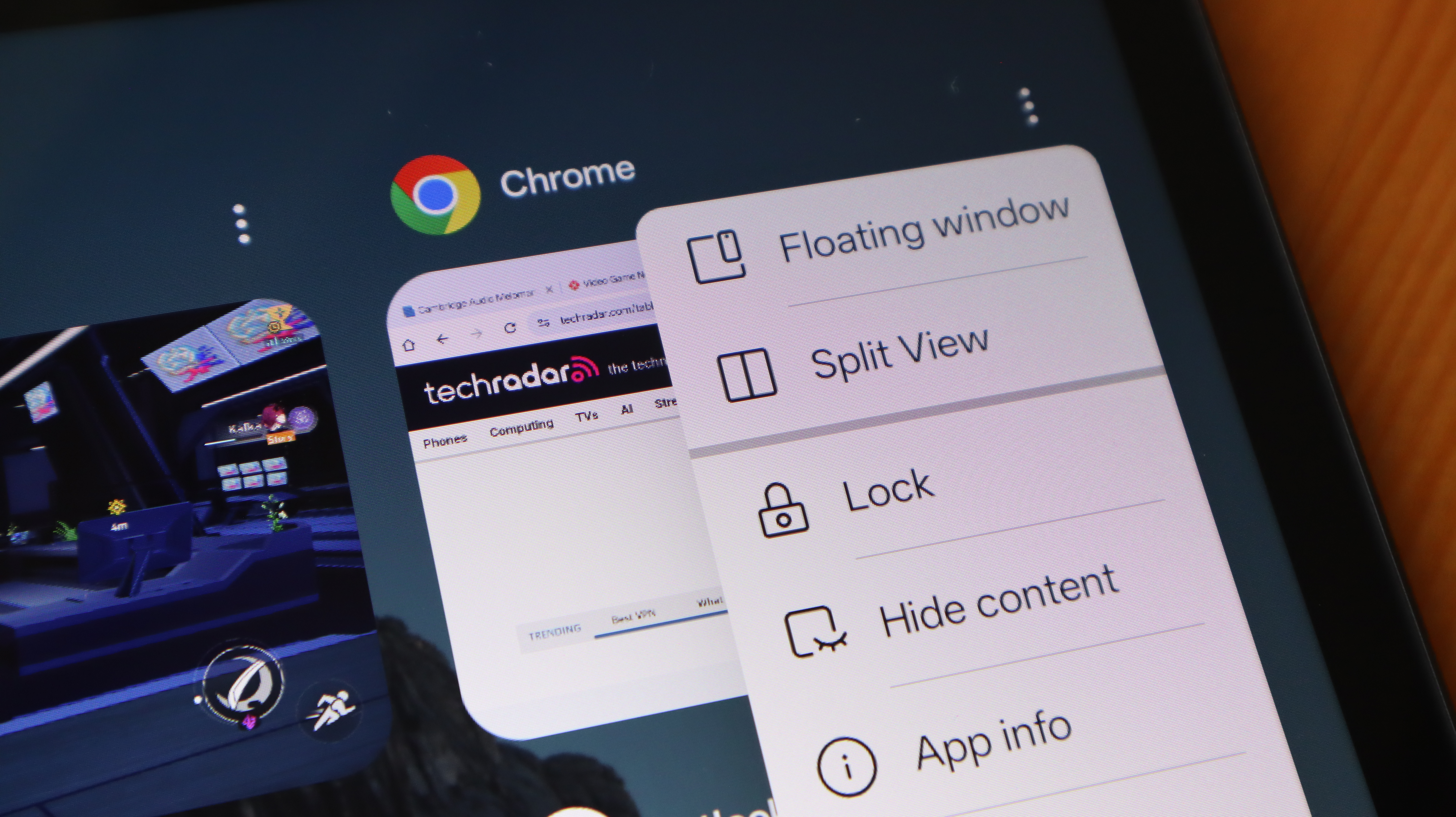
Because the Pad Lite’s 16:10 ratio is designed more with entertainment in mind, and to be used as a handheld device, multitasking feels both a little cramped and cumbersome. To see if this feeling remained when using the Pad Lite as a productivity device, I propped up the Pad Lite on a desk and set-up a Bluetooth connection with the Logitech Pop Icon Keys and the Pop Icon Mouse.
While Open Canvas definitely fairs a lot better with this set-up, it’s not quite as seamless as it is on the Pad 3, and for whatever reason the three-dots that previously appeared at the top of each app, acting as a quick menu for activating Open Canvas, are nowhere to be seen. Instead, you have to open up the app dashboard, and use the settings there to see the side-by-side combination that you desire. It’s all a bit too finicky for my liking, but again, for £199 I wouldn’t expect the OnePlus Pad Lite to be a productivity tablet.
There’s also no sign of OnePlus’ AI software either. You still get access to Google Gemini at the press of a button (or via voice command) but helpful tools like AI summaries on webpages simply aren’t here. This probably won’t be a dealbreaker for most people tempted by the OnePlus Pad Lite, but it’s still worth noting.
What is great to see however is the inclusion of O+ Connect, which lets you send files from the Pad Lite to an iPhone or MacBook fairly seamlessly. I say fairly because it’s still nowhere near as instantaneous as AirDrop. Yet compared to how much of a headache communication between Android and iOS devices has been in the past, this feels like a genuine fix, making the Pad Lite an even better option not just for those already invested in Android, but those who currently use an iPhone too.
From the time of launch, the OnePlus Pad Lite will be supported with updates until 2031, which means you’ll be getting plenty bang for your buck if you do decide to hold onto this tablet for the long-term.
- Software score: 4 / 5
OnePlus Pad Lite review: performance
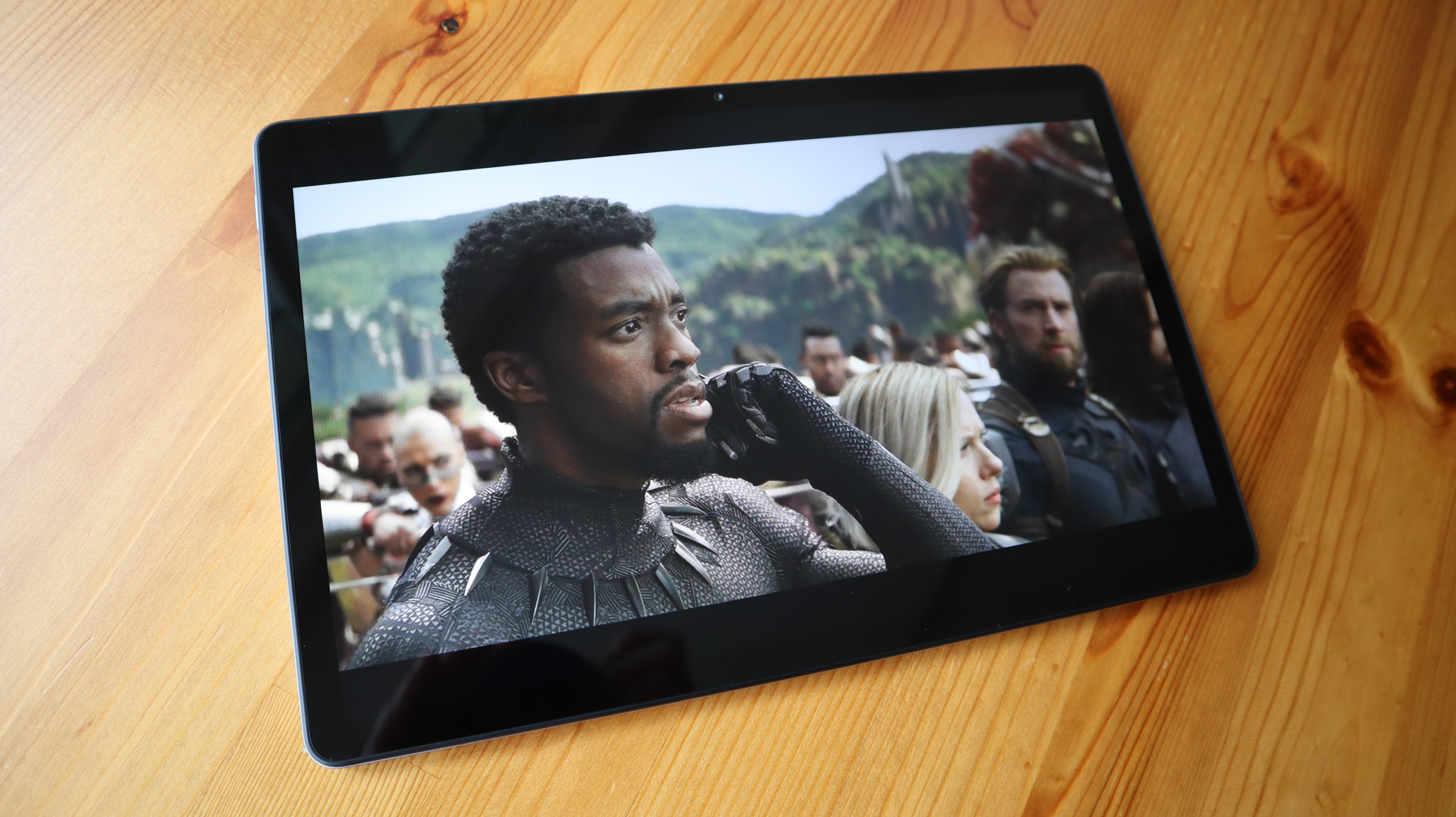
- The MediaTek chipset handles regular apps with ease
- It can slow down when playing more intensive games
I’ll be honest, when I saw the price tag of the OnePlus Pad Lite, I did brace for impact, anticipating performance that would feel completely at odds with some of the pricier devices I’ve been testing lately. Thankfully, OnePlus has managed to deliver an enjoyable experience here too.
Under the hood is the MediaTek Helio G100, and while the chipset certainly has its limitations, it still provides power where it counts. When it comes to jumping from one app to the next, streaming content or even dabbling in a bit of gaming, the processor more than gets the job done.
For low-intensity games like Beatstar, the OnePlus Pad Lite was able to blitz through them with ease, and even offer solid performance with some 3D titles. Booting up a multiplayer match in Call of Duty Mobile, I was impressed to see the Pad Lite keep up with the action, and although there was the odd moment of lag which you wouldn’t see on a pricier device, it never derailed the gameplay. For anything beyond this however, you’ll want to invest in a more powerful device for coherent gameplay.
When it comes to multitasking, the aforementioned Open Canvas software was able to run quite well when I would have Google Chrome open alongside Google Docs, just as an example. This means that for folks with workloads that use less-intensive apps, you can technically get on fine with using the tablet for productivity if you absolutely have to, but add any more than that and it starts to fall apart.
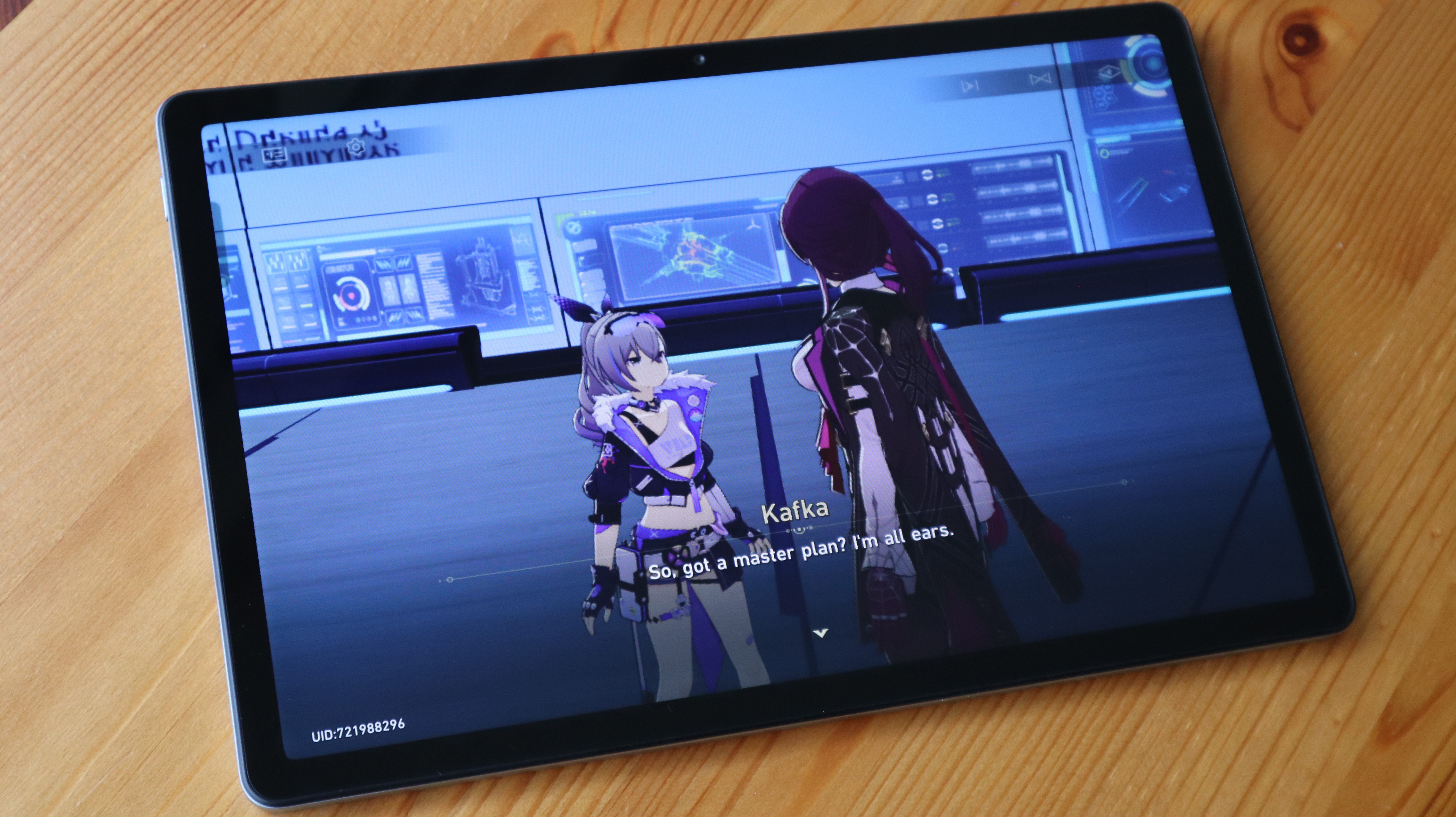
With those two apps open side-by-side (and a mouse and keyboard wirelessly connected), I then opened Disney Plus as a floating window and had a stream playing in the top-right corner of the display. Once that stream started, I noticed slowdown in how the cursor moved on screen, and when scrolling through a document. For context, the OnePlus Pad 3 had no such problems with this exact same task, so you’re better off opting for that tablet if you want more than just light entertainment.
When it does come to those apps however, the stereo speakers built into the device do a great job of keeping you engrossed if you don’t have a pair of headphones to hand. They definitely fare quite a bit better when watching films – running through my favourite Spotify playlists showed that the layers of a song, while present, don’t have a depth of separation between them. Still, there is a nice emphasis on the vocals that makes it easy to hear what’s being said.
- Performance score: 4 / 5
OnePlus Pad Lite review: battery
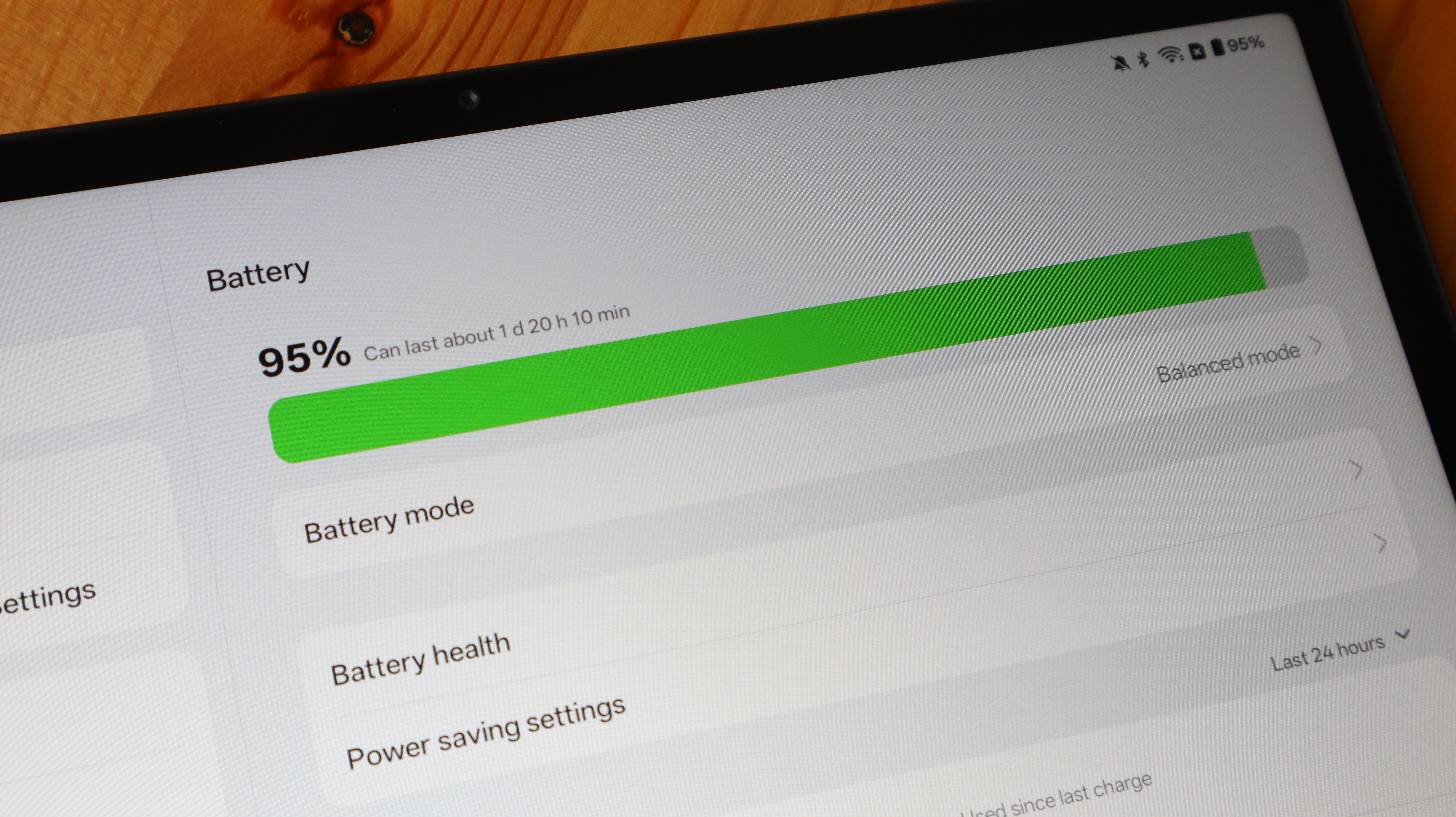
- Can easily last a whole day on a single charge
- No charging brick included
It’s rare that a OnePlus device doesn’t deliver on battery life, whether in a smartwatch or a smartphone, so the company has made sure to keep that trend going by including a large 9,340mAh cell within the OnePlus Pad Lite.
According to OnePlus, you can get up to 11-hours of video playback from a single charge. Putting this to the test, I set up a stream of Inside Out via Disney Plus, and let that play for an hour at roughly one third of the maximum volume. By the end of that hour, the battery has drained by 8%, so I do think that the claim holds up if you’re more on the conservative side of things.
Still, that longevity is more than enough to get you through a long journey, and certainly through to the end of the day. When it does come time to give the battery a top-up, you can make use of 33W wired charging, although there isn’t a charger included in the box, just OnePlus’ signature red USB-C cable.
When depleting the battery fully, it then took a total of one hour and 49 minutes to charge it back up to 100%. If you don't have quite as much time, I was able to get about 80% of the way there after just an hour and 17 minutes.
- Battery score: 4.5 / 5
Should you buy the OnePlus Pad Lite?
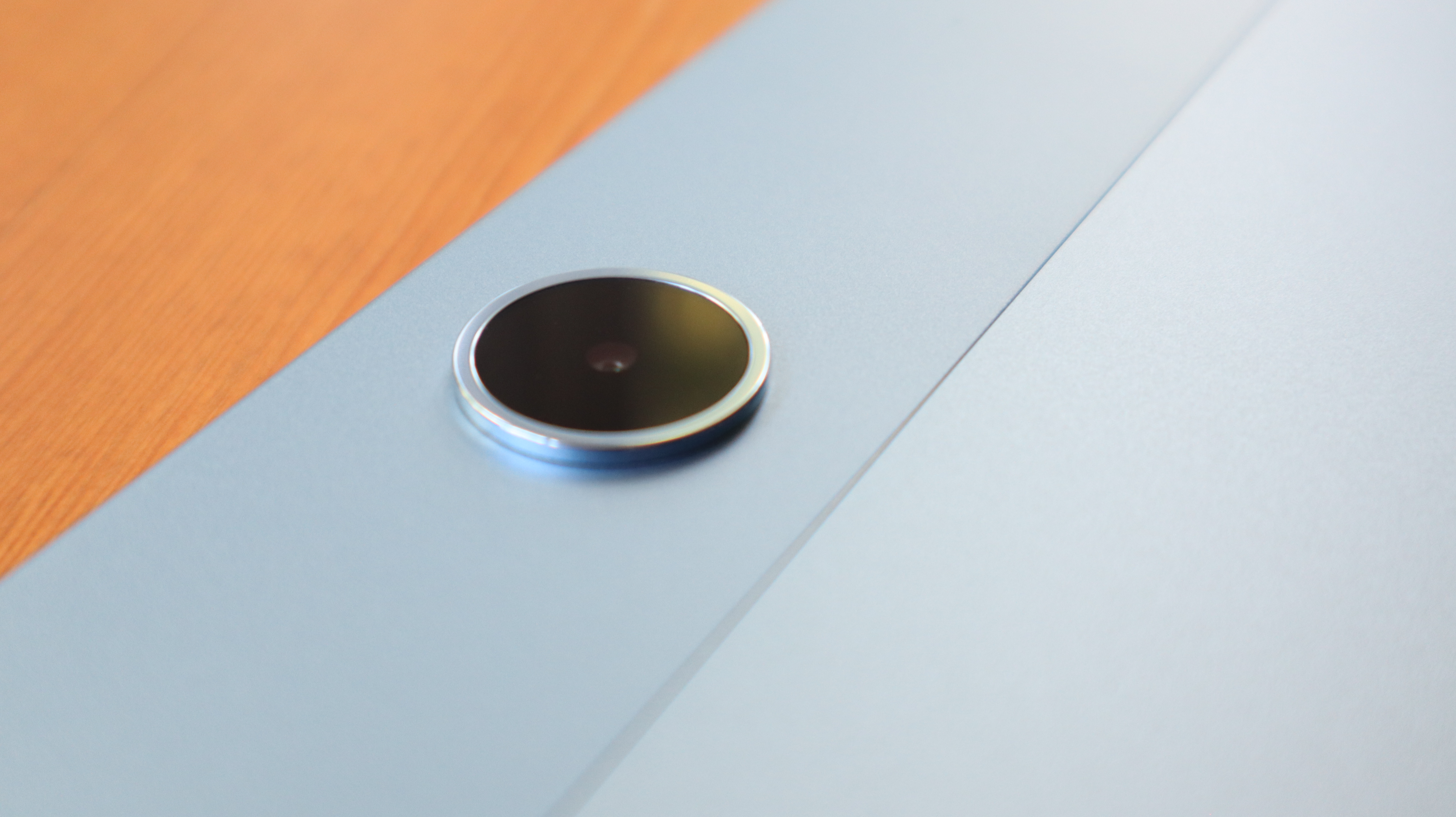
Attributes | Notes | Rating |
|---|---|---|
Value | As a budget tablet with a great screen and even better software, the OnePlus Pad Lite can't be beat | 5 / 5 |
Display | The wide aspect ratio makes the display well suited for films and playing certain games on the go | 4 / 5 |
Design | The Pad Lite looks great and is lightweight enough to carry in a bag, but it's not ideal for reading when held upright | 4 / 5 |
Software | OxygenOS is as pleasing to the eye as it's ever been, and it keeps the experience free of major bloatware | 4 / 5 |
Performance | The MediaTek chipset can handle light multitasking well, but anything more intensive and it really struggles | 4 / 5 |
Battery | You can easily get a day of use out of this battery, making it ideal for long journeys | 4.5 / 5 |
Buy it if…
You need a tablet for entertainment
With its wide 11-inch display, the OnePlus offers a great cinematic experience at a price that’s more than reasonable.
You appreciate a clean take on Android
Despite its budget price tag, the Pad Lite is almost free of bloatware, and OxygenOS is just very easy on the eyes.
You require light multitasking
Enjoy reading an article while watching a YouTube video? You’ll love Open Canvas multitasking on the Pad Lite.
Don’t buy it if…
You need a tablet for productivity
The more squat display of the Pad Lite, not to mention the limitations of its chipset, don’t allow for an experience as conducive to productivity as the OnePlus Pad 3.
You enjoy high-end gaming
While it can run Call of Duty Mobile perfectly well, more intensive titles are just too much for the Pad Lite’s chipset.
You want a tablet exclusively for reading
The tall design of the Pad Lite isn’t the most comfortable to hold vertically, so you’re better off with a smaller pick like the iPad mini if you want a tablet for reading ebooks upright.
Also consider
Not convinced by what OnePlus Pad Lite brings to the table? Here are some alternatives worth checking out:
| Header Cell - Column 0 | OnePlus Pad Lite | Apple iPad 11-inch (2025) | Apple iPad mini 8.3-inch (2024) |
|---|---|---|---|
Price | £199 / €229 | $349 / £329 | $1,199.99 / £1,199 (now regularly discounted) |
Base storage | 128GB | 128GB / 236GB / 512GB | 128GB / 256GB / 512GB |
Screen size | 11-inch 1920 x 1200 LCD, 90Hz | 11-inch Liquid Retina, 60Hz | 8.3-inch Liquid Retina, 60Hz |
Chipset | MediaTek Helio G100 | Apple A16 Bionic | Apple A17 Pro |
Battery | 9,340mAh | 28.93Wh | 19.3Wh |
Charging | 33W | 20W | 20W |
Cameras | 5MP main, 5MP front | 12MP main, 12MP front | 12MP main, 12MP front |
OS | OxygenOS w/ Android 15 | iPadOS 18 | iPadOS 18 |
Apple iPad 11-inch (2025)
Although it is a fair bit more expensive than the OnePlus Pad Lite, the entry-level iPad is still a far better option when it comes to productivity. The superior optimisation of iPadOS apps, in conjunction with the seamless multitasking software developed by Apple, makes this a great option for students and anyone who wants a smaller device to work on than a typical laptop.
Read our full Apple iPad 11-inch (2025) review
Apple iPad mini 8.3-inch (2024)
When it comes to watching entertainment, the OnePlus Pad Lite is the better buy, but thanks to its miniature sizing that’s far easier to use one-handed, the iPad mini can’t be beat for reading articles, graphic novels and ebooks on the go. Plus, the smaller frame makes it even more portable than OnePlus’ tablet, so much so that you could even fit it inside a crossbody bag.
Read our full Apple iPad mini 8.3-inch (2024) review
How I tested the OnePlus Pad Lite
For the purpose of this review, I used and tested the OnePlus Pad Lite over the course of a week, giving me a chance to see not just how the tablet performs against my usual testing benchmarks, but also how it fared against everyday use.
The testing of the speakers was conducted by playing music via a Spotify Premium account, whereas tests for the capabilities of the display were handled by playing IMAX enhanced films on Disney Plus and YouTube videos at full screen.
For testing the limits of the chipset, the main gaming test involved playing Call of Duty Mobile online, but I also downloaded and played Honkai: Star Rail for enough time until I was happy to build a definitive report.
First reviewed August 2025

After cutting his teeth covering the film and TV industries, Tom spent almost seven years testing the latest tech over at Trusted Reviews before heading out into the world of freelance writing. From vacuum cleaners to video games, there isn't much that Tom hasn't written about, but being something of a gym fanatic, he tends to harbour an obsession where smartwatches are concerned.
You must confirm your public display name before commenting
Please logout and then login again, you will then be prompted to enter your display name.
